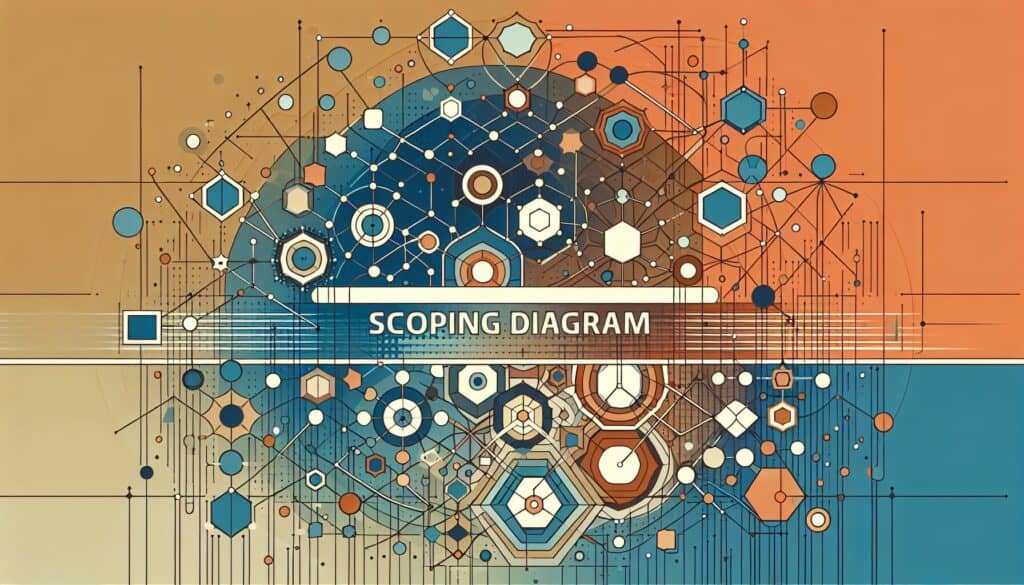Definition der Grenzen eines zu überprüfenden Prozesses oder Systems, wobei die Interaktionen mit externen Einheiten aufgezeigt werden.
- Methodologien: Kunden & Marketing, Wirtschaft
Scoping-Diagramm

Scoping-Diagramm
- Agile Methodik, Kontinuierliche Verbesserung, Design Denken, Prozessabbildung, Projektmanagement, Qualitätsmanagement, Systemmodellierungssprache (SysML), Wertstrom-Mapping
Zielsetzung:
Wie es verwendet wird:
- Ein visuelles Hilfsmittel auf hoher Ebene, das den Prozess oder das System, der/das in den Anwendungsbereich fällt, in den Mittelpunkt stellt und dessen Inputs von und Outputs für die Beteiligten, andere Prozesse oder Systeme veranschaulicht. Es hilft zu klären, was in einem Projekt oder einer Analyse enthalten ist und was nicht.
Vorteile
- Definiert klar die Projekt- oder Prozessgrenzen; Hilft bei der Identifizierung der wichtigsten Interessengruppen und Schnittstellen; Erleichtert das gemeinsame Verständnis unter den Teammitgliedern; Nützlich für die erste Analyse und Problemdefinition.
Nachteile
- Bietet eine Übersicht auf hoher Ebene und lässt interne Details vermissen; kann komplexe Interaktionen zu stark vereinfachen, wenn es nicht sorgfältig verwendet wird; die Definition des "Anwendungsbereichs" kann trotz des Diagramms immer noch diskutiert werden.
Kategorien:
- Problemlösung, Produktdesign, Projektmanagement
Am besten geeignet für:
- Schaffung eines klaren Verständnisses dafür, was ein Projekt oder eine Prozessanalyse abdeckt und was nicht, indem die externen Verbindungen visualisiert werden.
The Scoping Diagram serves as an integral tool in various stages of product design and engineering, particularly during the initial phases of project definition and requirement gathering, where clarity of scope is paramount. It finds applications across industries such as automotive, aerospace, consumer electronics, and healthcare, where complex systems and multiple stakeholders are involved. By visually mapping out the relationships between the central process or system and its external elements, stakeholders can easily identify essential interfaces, dependencies, and the boundaries of the project. Engaging participants such as project managers, engineers, designers, and even end-users in this visualization activity can facilitate a collaborative environment, fostering a shared understanding of the project’s focus. This method proves valuable during workshops or brainstorming sessions aimed at framing project objectives or analyzing Prozessleistung, allowing teams to clarify expectations and potentially identify areas for innovation. The visual representation aids in differentiating between what will be included in the scope and what will be explicitly excluded, thus preventing scope creep later in development. Clarity in defining these boundaries accelerates decision-making processes and helps teams avoid miscommunications that may arise during subsequent project phases.
Die wichtigsten Schritte dieser Methodik
- Identify the main process or system to be scoped.
- Outline the key stakeholders involved with the process or system.
- Determine the inputs required from stakeholders and other systems.
- Define the expected outputs and deliverables to stakeholders and systems.
- Visualize the connections between the process or system and its external elements.
- Specify the boundaries and limits of the project or analysis.
- Review and refine the diagram with stakeholder feedback for accuracy.
- Finalize the scoping diagram for use in project planning and communication.
Profi-Tipps
- Involve cross-functional team members in scoping sessions to leverage diverse viewpoints, ensuring comprehensive coverage of all relevant areas.
- Utilize iterative revisions of the Scoping Diagram during project phases to incorporate evolving insights and maintain alignment with stakeholder needs.
- Document assumptions and limitations adjacent to the Scoping Diagram for transparency, enabling informed decision-making throughout the project lifecycle.
Verschiedene Methoden lesen und vergleichen, Wir empfehlen die
> Umfassendes Methoden-Repository <
zusammen mit den über 400 anderen Methoden.
Ihre Kommentare zu dieser Methodik oder zusätzliche Informationen sind willkommen auf der Kommentarbereich unten ↓ , sowie alle ingenieursbezogenen Ideen oder Links.
Historischer Kontext
1949
1950
1950
1960
1960
1960
1960
1940
1950
1950
1958
1960
1960
1960
1960
(wenn das Datum nicht bekannt oder nicht relevant ist, z. B. "Strömungsmechanik", wird eine gerundete Schätzung des bemerkenswerten Erscheinens angegeben)















Verwandte Artikel
Fragebögen zu muskuloskelettalen Beschwerden
Multivariate Tests (MVT)
Mehrfache Regressionsanalyse
Motion-Capture-Systeme
MoSCoW-Methode
Moods Median-Test